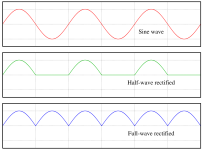Sort of. A diode would simply discard the negative part of the waveform and you would get only half the power available. Called half wave rectified.
A rectifier is an arrangement of diodes that, instead of discarding the negative lump of the alternating current, it flips the negative lump over, to above the zero line. So instead of AC which is one positive lump followed by a negative lump (alternating), you now get two positive lumps. Which is a form of DC, a lumpy DC. A better rectifier might simply have more current capacity, or could have additional components that smooth it out more. The battery will smooth it out some too, a lot - if its not fully charged yet thus has the capacity to accept all of the power that it gets.
Here's a pic from Wikipedia of alternating current (sine wave); half wave rectified, and full wave rectified.

One way to get some understanding is to think of your flywheel/coil unit like a 2-piston hydraulic pump (one piston up, one piston down). Flow is amps, pressure is volts. Diodes are check valves. A rectifier would be the arrangement of check-valves that you would need to make ALL of the oil flow in one direction, without wasting any flow. You would need other components to get smooth flow but hydraulic pumps are not as crude as this '2-piston' analogy.
You can think of that 2nd coil you added like another pair of crankshaft arms (& pistons), a few degrees off angle from the original.
I can't offer much more, this is appx the limit of my understanding.

